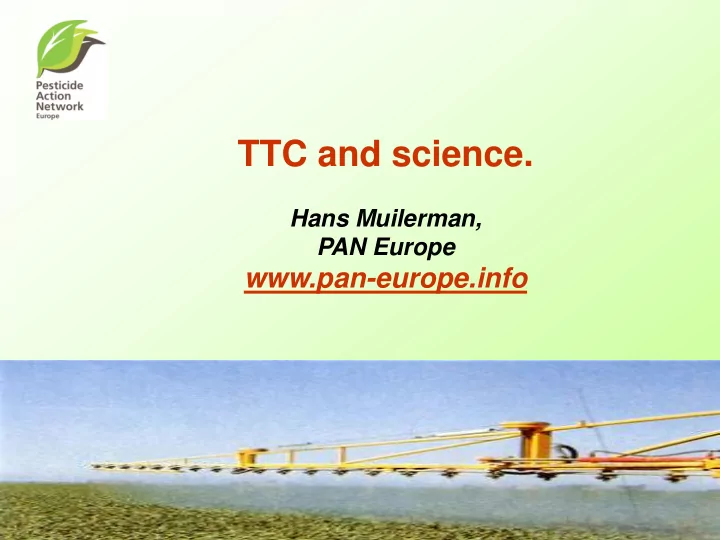

TTC and science. Hans Muilerman, PAN Europe www.pan-europe.info
TTC, science or politics? • How does a pragmatic, US non-precautionary principle style, tool fit in the EU toolbox? • EFSA opinion: “Safe level” but also “likely without harm” – safe or not safe? • EFSA: “it is a probability - based screening tool”, “it does not offer complete certainty”, but………. • …nevertheless used in full risk assessment (flavouring, pesticide residues in groundwater) • Use for infants below 6 months on a “case -by- case” basis – how is this implemented in flavouring, groundwater? What about the unborn? • Dozens of industry-sponsored studies on PubMed; no independent scientists involved • 2012 – Court of Auditors report criticized the opinion
The ‘Munro’ database underpinning TTC • The Munro database is very old, many studies are 50, 60 year old, and the protocols used for toxicity testing miss decades of scientific insights • Most studies in the database are subchronic, sometimes even 15-days exposure tests included; much information is lacking such as testing doses and duration of the experiment • Out of 613 studies there were, 2 ovarian endpoints, NO immunotoxic endpoint, 4 endocrine disrupting endpoints and 5 testicular endpoints • The studies are very insensitive due to high unrealistic testing doses while low dose exposure is missing and subtle effects such as on endocrine disruption and developmental neurotoxicity will be disregarded; • EFSA, CC III: “In the majority of cases, the cited source was a company report, … and was not retrievable” – no peer review possible • In the big majority of the cases a NOEL is not observed at all in the animal tests • From the database “NOEL” to TTC arbitrarily ‘adjustments’ were applied: sometimes a factor 3 from subchronic to chronic, sometimes not; for some reprotoxic and teratogenicity studies ‘adjustments’ were applied, for others not; • Munro database unfit for purpose
Genotoxic substances • EU doesn’t allow genotoxic substances on the market (Reg. 1107/2009, Annex II, 3.6.2, excludes mutagens categorally from the market); so why a tool to allow them on the market to begin with? • Again imposing US-policy (linear extrapolation from TD-50) on the EU in contrast to the no-threshold/hazard approach of the EU for genotoxics • Removing some groups of “high potency carcinogens” artificially increases the TTC for genotoxics – are all unknown genotoxics of “low potency” as a matter of principle? • SANCO scientific committees acknowledges weak scientific basis • Genotoxic is also very narrowly defined as DNA change (mutations); nothing on epigenetic changes, changes of germs cells, chromosome folding, micro-RNA,and multigenerational effects, missing decades of scientific insights • Genotoxic metabolites are ignored (only “if known”, which is rarely the case) • EFSA already encourages to use another ‘pragmatic tool’ for genotoxics, the margin of exposure, in food and feed
Cramer ‘classes’ • The ‘classes’: Simple structures - May suggest significant toxicity and Something in between - based on 33 questions (1978) • Class III contains nearly all industrial chemicals • Arbitrarily removing some groups (organophosphates and carbamates) • Only “known” endocrines excluded; generally not known if a chemical is an endocrine and thus made subject to TTC • At the same time EFSA is developing groups for cumulative assessment – no coherent policy • Extreme wide “classes” in Cramer in total contrast to the extreme narrow “classes” in other EFSA opinions (CAG’s on azoles, 2009) – double standards
Probabilistic approach • Regulation 1107/2009 Art.4.2.a: “ they shall not have any harmful effects on human health, including that of vulnerable groups ”; TTC is legally unacceptable • Why not a 99% cut-off or 99,9%? Arbitrary decision and not within the mandate of EFSA • What is the level of protection? Insight is lacking. • Probabilistic modelling is in contrast to current EU deterministic use - similar probabilistic approach for pesticide residues was qualified by WHO as a “paradigm change”
Conservative? TTC (CC III) compared with independent literature 1000000 150000 Toxic 100000 effect observed 10000 5000 5000 3000 in ng/kg 2000 2000 1500 1000 1000 bw. Day 530 200 100 100 20 10 Atrazin Bisphenol A Haloxyfop.M DES BDE-47 Fenarimole Delmethrin Dieldrin HCB TBT Lowest "safe"TTC NOEL "Safe" TTC level
TTC is in contrast very unconservative • The 5-percentile TTC cut-off disregards many lower dose effects • The EFSA CC III claim: “…results in a TTC value that is approximately 3- fold lower than the lowest NOEL value…” – is a false claim, it is in fact >75x higher !! • The factor 100 from the TTC-NOEL is not adequate for protecting the vulnerable e.g. the unborn • Martin et al. 2013 show that the factor 100 is not a worse case but exceeded in several cases such as the intraspecies variation factor for neonatals (also Dorne at al. 2001) • On top of this mixture effects (cumulative, synergetic) are not taken into account by TTC; Backhaus et al. 2010 propose an extra safety factor • Level of protection is unknown for TTC but not conservative; a safety factor of 1000 in stead of 100 would be an improvement but still insufficient
Conclusions • TTC is based on decades old science while EU legislation obliges to start from current science • Developmental neurotoxicity, endocrine disruption and many other health-threathening adverse effects are not/hardly covered • The Cramer classification is composed in an arbitrarily way and not based on science; strange contrast to the EFSA cumulative groups • TTC is far from conservative; adverse effects occur at and below this level, TTC is not protecting the vulnerable and TTC ignores mixture effects • A probabilistic approach is a violation of Art.5 of Regulation 1107/2009 -not any harmful effect is allowed • It is a step in the pitch dark – no level of protection is known
Recommend
More recommend